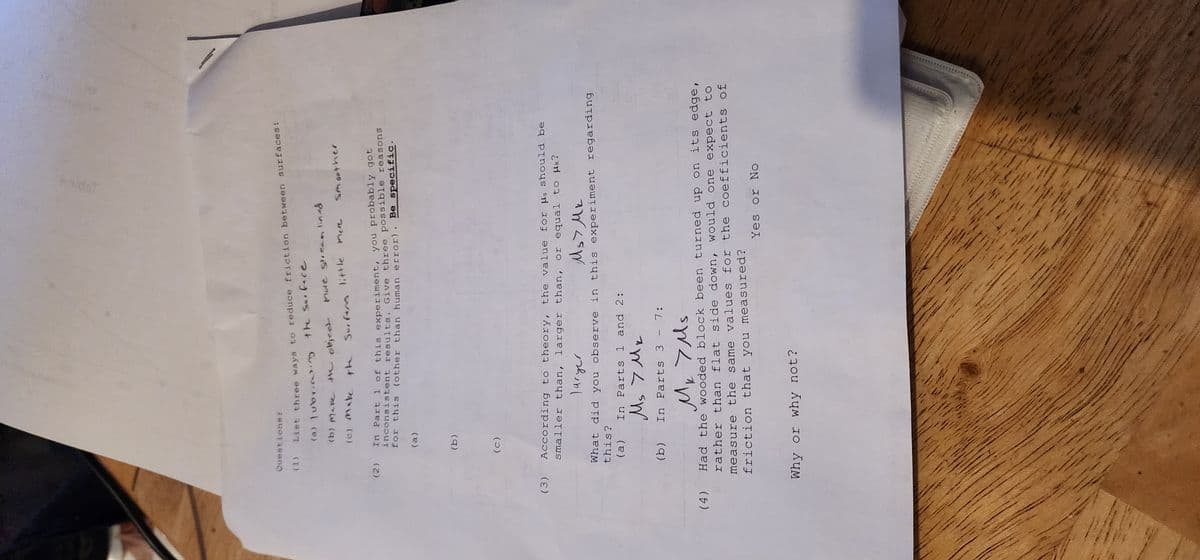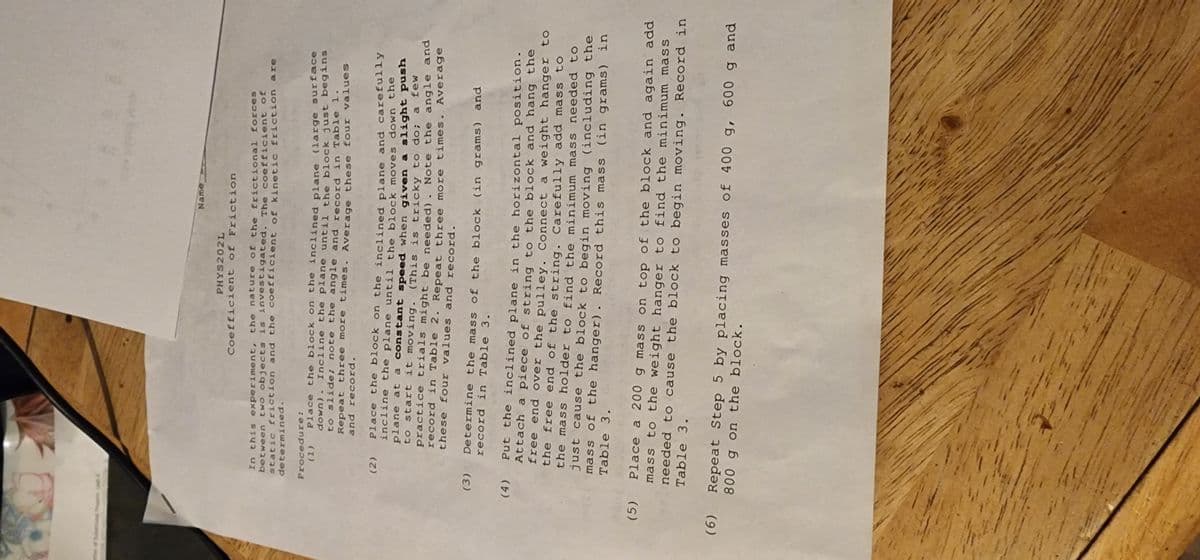Questioner (1) List three ways to reduce friction between surfaces: (a) lubrinting the surface (b) make the object (e) Make th 4) (b) (c) mure streamlined Mer (2) In Part 1 of this experiment, you probably got inconsistent results. Give three possible reasons for this (other than human error). Be specific. (a) Surform little (3) According to theory, the value for u. should be smaller than, larger than, or equal to μk? Smoother larger Ms > Mk What did you observe in this experiment regarding this? (a) In Parts 1 and 2: Мы умк (b) In Parts 3 - 7: Why or why not? M₂ 7 Ms Had the wooded block been turned up on its edge, rather than flat side down, would one expect to measure the same values for the coefficients of friction that you measured? Yes or No
Questioner (1) List three ways to reduce friction between surfaces: (a) lubrinting the surface (b) make the object (e) Make th 4) (b) (c) mure streamlined Mer (2) In Part 1 of this experiment, you probably got inconsistent results. Give three possible reasons for this (other than human error). Be specific. (a) Surform little (3) According to theory, the value for u. should be smaller than, larger than, or equal to μk? Smoother larger Ms > Mk What did you observe in this experiment regarding this? (a) In Parts 1 and 2: Мы умк (b) In Parts 3 - 7: Why or why not? M₂ 7 Ms Had the wooded block been turned up on its edge, rather than flat side down, would one expect to measure the same values for the coefficients of friction that you measured? Yes or No
University Physics Volume 1
18th Edition
ISBN:9781938168277
Author:William Moebs, Samuel J. Ling, Jeff Sanny
Publisher:William Moebs, Samuel J. Ling, Jeff Sanny
Chapter6: Applications Of Newton's Laws
Section: Chapter Questions
Problem 123AP: Two blocks connected by a string are pulled across a horizontal surface by a force applied to one of...
Related questions
Question
Need question 2 and question 4

Transcribed Image Text:Questions:
(1) List three ways to reduce friction between surfaces:
(a) lubricting the surface.
(b) make the object
(c) Make the surfaces little
(4)
(a)
(b)
(2) In Part 1 of this experiment, you probably got
inconsistent results. Give three possible reasons
(other than human error). Be specific.
for this
(c)
More Streamlined
(3) According to theory, the value for us should be
smaller than, larger than, or equal to Mk?
мумк
mer
(a) In Parts 1 and 2:
Ms 7 Mx
Smoother
larger
What did you observe in this experiment regarding
this?
(b)
Why or why not?
In Parts 3 - 7:
Мк умс
Had the wooded block been turned up on its edge,
rather than flat side down, would one expect to
measure the same values for the coefficients of
friction that you measured?
Yes or No
*******************

Transcribed Image Text:Name
PHYS202L
Coefficient of Friction
In this experiment, the nature of the frictional forces
between two objects is investigated. The coefficient of
static friction and the coefficient of kinetic friction are
determined.
Procedure:
(1) Place the block on the inclined plane (large surface
down). Incline the plane until the block just begins
to slide; note the angle and record in Table 1.
Repeat three more times. Average these four values
and record.
(2) Place the block on the inclined plane and carefully
incline the plane until the block moves down the
plane at a constant speed when given a slight push
to start it moving. (This is tricky to do; a few
practice trials might be needed). Note the angle and
record in Table 2. Repeat three more times. Average
these four values and record.
(3) Determine the mass of the block (in grams) and
record in Table 3.
(4) Put the inclined plane in the horizontal position.
Attach a piece of string to the block and hang the
free end over the pulley. Connect a weight hanger to
the free end of the string. Carefully add mass to
the mass holder to find the minimum mass needed to
just cause the block to begin moving (including the
Table 3. u
mass of the hanger). Record this mass (in grams) in
(5) Place a 200 g mass on top of the block and again add
mass to the weight hanger to find the minimum mass
needed to cause the block to begin moving. Record in
Table 3.
800 g on the block.
(6) Repeat Step 5 by placing masses of 400 g, 600 g and
Expert Solution
Step 1
When there is a relative motion or tendency of relative motion between two rough surfaces then friction force comes in to existence. Friction may support a motion or oppose a motion but it always opposes relative motion. Friction forces are of two type :
1. Static friction : When there is tendency of relative motion but no actual relative motion between the surfaces then the friction force between the surfaces is called static friction force.
2. Kinetic friction : When there is a relative motion between the surfaces, kinetic friction works between the surfaces.
Trending now
This is a popular solution!
Step by step
Solved in 3 steps

Knowledge Booster
Learn more about
Need a deep-dive on the concept behind this application? Look no further. Learn more about this topic, physics and related others by exploring similar questions and additional content below.Recommended textbooks for you

University Physics Volume 1
Physics
ISBN:
9781938168277
Author:
William Moebs, Samuel J. Ling, Jeff Sanny
Publisher:
OpenStax - Rice University

Physics for Scientists and Engineers: Foundations…
Physics
ISBN:
9781133939146
Author:
Katz, Debora M.
Publisher:
Cengage Learning

An Introduction to Physical Science
Physics
ISBN:
9781305079137
Author:
James Shipman, Jerry D. Wilson, Charles A. Higgins, Omar Torres
Publisher:
Cengage Learning

University Physics Volume 1
Physics
ISBN:
9781938168277
Author:
William Moebs, Samuel J. Ling, Jeff Sanny
Publisher:
OpenStax - Rice University

Physics for Scientists and Engineers: Foundations…
Physics
ISBN:
9781133939146
Author:
Katz, Debora M.
Publisher:
Cengage Learning

An Introduction to Physical Science
Physics
ISBN:
9781305079137
Author:
James Shipman, Jerry D. Wilson, Charles A. Higgins, Omar Torres
Publisher:
Cengage Learning